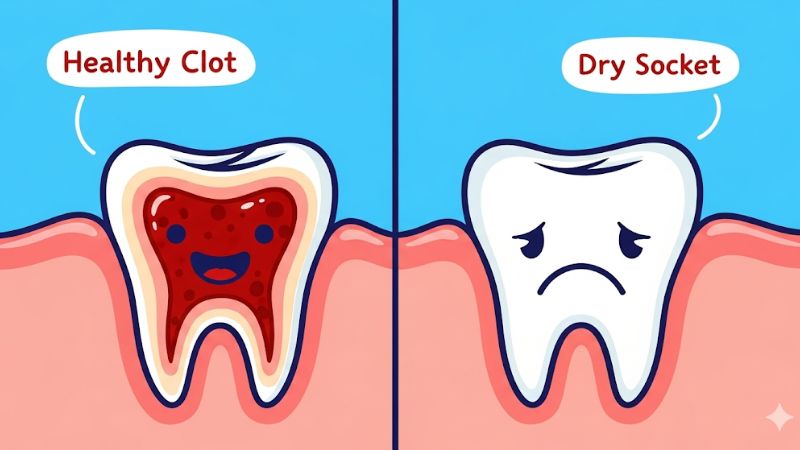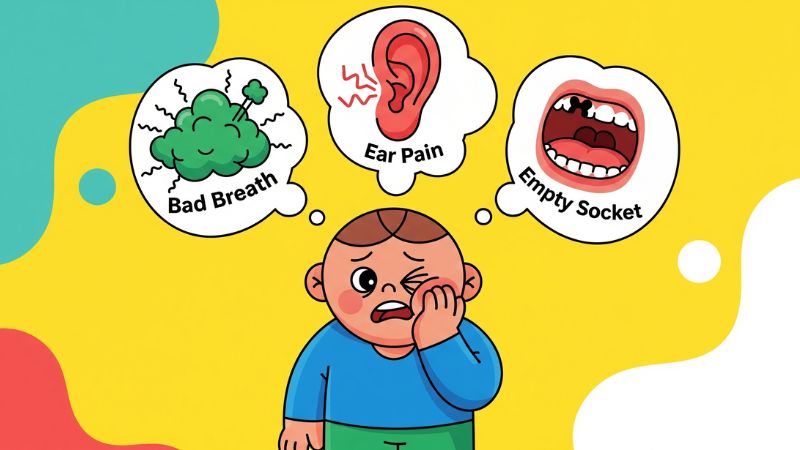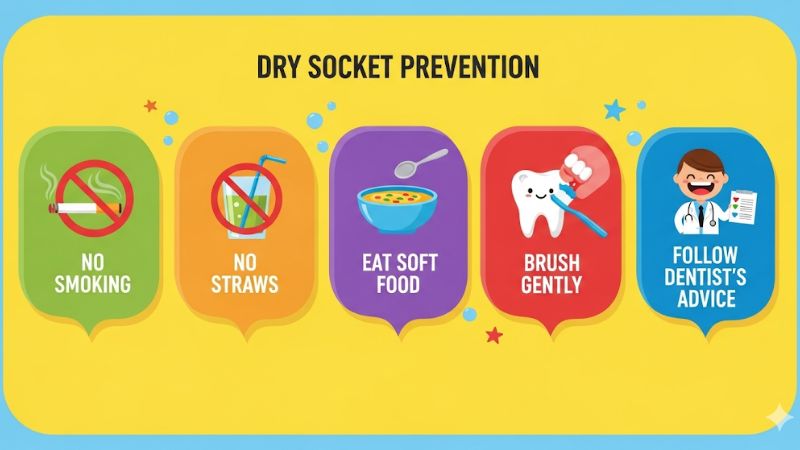Table of Contents
When you go to the dentist to remove a tooth, the mouth usually heals slowly and safely. But sometimes, after a tooth is taken out, a painful problem called dry socket can happen. Many people don’t know what it is or what it looks like, which can make them worried. Don’t worry—this article explains dry socket in a simple way so you can understand it better.

What Is a Dry Socket?
After a tooth is removed, the dentist expects a blood clot to form in the empty space (the socket). This blood clot works like a natural bandage. It protects the bone and nerves underneath and helps the wound heal.

But if this blood clot does not form, or it breaks away too early, the bone and nerves are left open. This open and painful condition is called a dry socket.
So, a dry socket is basically an empty tooth hole that has not healed properly.
Why Does Dry Socket Happen?
There are a few common reasons:
- Blood clot is disturbed – Eating hard foods, drinking through a straw, or brushing too hard can knock the clot out.
- Smoking – The sucking motion and chemicals in cigarettes can stop healing.
- Infection – Germs in the mouth may prevent the clot from forming.
- Difficult tooth removal – Wisdom teeth are more likely to cause dry socket.
What Does a Dry Socket Look Like?
Normally, after a tooth is taken out, you see a dark red blood clot filling the hole. This means healing is happening.
But with a dry socket, things look different:
- The socket looks empty, with no clot.
- You may see white bone at the bottom of the hole.
- Sometimes, the hole looks gray, yellow, or dry instead of red.
- The gums around it may look swollen.
In short, instead of a healing wound, the socket looks bare, as if something is missing.

How Does Dry Socket Feel?
Dry socket is not just about how it looks—it also hurts a lot. Here are the common signs:
- Severe pain a few days after the tooth was removed.
- Pain that spreads to the ear, eye, or neck on the same side.
- Bad breath or a foul taste in the mouth.
- Swelling and discomfort near the gums.
This pain is much worse than the normal healing pain.
Who Can Get Dry Socket?
Anyone can get dry socket, but it is more common if:
- You smoke or chew tobacco.
- You don’t keep your mouth clean after surgery.
- You had a very hard tooth extraction (like wisdom teeth).
- You use straws or spit forcefully after surgery.
- You have had dry socket before.
How Long Does Dry Socket Last?
Without treatment, dry socket can last up to 7–10 days. But with the right care from a dentist, the pain can be reduced in just a few days, and healing gets faster.
How Dentists Treat Dry Socket
If you think you have dry socket, it’s important to visit the dentist quickly. The dentist may:
- Clean the socket to remove food or germs.
- Put medicine inside the socket to reduce pain.
- Give painkillers to make you feel better.
- Give antibiotics if there is infection.
This treatment makes the healing smoother and helps the pain go away faster.
How to Prevent Dry Socket
Good news! You can avoid dry socket by being careful after a tooth removal.
Here are some easy tips:
- Don’t use straws for at least 1 week.
- Don’t smoke or chew tobacco.
- Eat soft foods like soup, yogurt, or mashed potatoes.
- Brush gently, especially near the surgery area.
- Drink water slowly instead of spitting hard.
- Follow all the dentist’s instructions.

Why Is It Called “Dry” Socket?
It’s called “dry” because, without the blood clot, the hole looks empty and dry. A normal healing socket looks moist and filled with a clot, but a dry socket looks bare, which is why the name fits.
When Should You Call the Dentist?
Call your dentist right away if you:
- Have very strong pain 3–5 days after a tooth is removed.
- Notice the socket looks empty or white.
- Have bad breath that doesn’t go away.
- Have swelling or fever.
Quick action can prevent bigger problems.
The Bottom Line
A dry socket is a painful problem that happens when the blood clot after a tooth removal does not form or gets lost. It looks empty, may show white bone, and causes strong pain.
The good news is that dentists can treat it easily, and you can prevent it by being careful after your tooth is removed. Remember, if you notice something unusual, always tell your dentist.
Key takeaway: Dry socket looks like an empty hole without a clot, feels very painful, and needs a dentist’s care.


